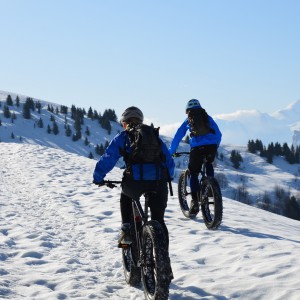Post by Mary on December 4, 2017
We’ve got some excellent early snow conditions in Morillon this year so we’ve already switched the trail bikes for fatties. Jamie and I will be out for our first taste of fatty fun tomorrow. To mark the change in seasons, here’s my interview with Jamie with his thoughts on winter mountain biking.
When did you first ride a bike on snow?
Apart from riding my bike around the lanes of Leeds as a child my first proper snow biking experience was the Iditabike race in Alaska in February 1996. The snow I was riding on was on top of a frozen lake and river! It was a 250 mile 2 day event through day and night in temperatures as low as minus 26 degrees. I was in about 4th or 5th place until I fell asleep at a check post and woke up in 20th position! I managed to ride back into 14th but I had discovered that I don’t like sleep deprivation or severe cold conditions! The most memorable moment was pre-dawn on the 2nd day, the sun was just rising and I could hear wolves howling in the woods around me. That made me speed up a bit!
How does your Idita bike experience compare with modern fat biking?
At the time of the Iditabike race fat tyres and rims weren’t available. We rode on the biggest tyres of the time – 2.4”. The snow was actually pretty grippy because it was so cold. The only problem was if you strayed from the hard packed trail you’d be in snow up to your waist! Nowadays the tyres on the fat bikes are 4.6”-4.8” with special wide rims. There’s a lot more grip and you can run really low pressure, which allows you to ride in warmer winter temperatures. The fat bikes definitely make winter mountain biking a lot more fun!
Why do you like riding through the winter months?
It’s good to keep the bike skills and fitness going through the winter. This winter I’m really going to need to keep the bike fitness going because I’ve just entered the toughest enduro race in Europe with 4,900m of ascent and descent in 1 day! It’s also just great to get out and have some fun on the bike in the winter months. I missed that until I got my fatty.
What’s the best winter ride you’ve done?
Up to the Refuge de Bostan above Samoens. It’s a challenging but enjoyable ride up a pisted track and the views from the top are well worth the effort. You get a warm welcome up at the Refuge, which stays open in the winter months. After a coffee and a rest the best reward is the fast blast back down, startling a few skiers and snow shoers on the way. Riding down the off-piste above the tree line is a lot of fun in different conditions! Have a look at this short film we made last season.
What do you think of electric fat bikes?
They’re good for people who wouldn’t otherwise get out on a bike but they’re not for me. I like the challenge of the climbs as well as the excitement of the descents. Maybe when I’m 80!
Where are the top 3 places in the world you’d like to ride your fat bike?
- Goms in the Swiss Valais. There’s apparently a great network of fat bike friendly pisted trails.
- The summit of the Tete de Bostan in our valley. I’d like to continue up from the Refuge one day and ride all the way down. It would be a tough carry up but hopefully worth the effort!
- Somewhere in Scandanavia, maybe Swedish Lapland. A winter point-to-point route would be good if I can find one!
When does the Alpine winter riding season start and end?
Whenever the first snow comes down to the valley floor. It could be November but usually mid-late December. This year we already have snow coverage everywhere so we’ve got the fatties out early. We can continue winter mountain biking right through to March or April, as long as the snow lasts. We do sometimes travel out of our valley to find good snow conditions. The Val Ferret in Courmayeur is a good place to ride. It holds the snow well and is very fat bike friendly.
What are the “must have” kit items for winter mountain biking in the Alps?
Warm gloves, thick socks and winter boots! I get cold hands and feet easily so these items are very important to me. The Five Ten high top boots with short gaiters work well but winter hiking boots are fine too. I’m on an eternal quest for the perfect winter glove. I’ll let you know when I find it! Layers are the way to go because you start off cold but warm up quickly once you start peddling. A thermal base layer and a winter riding jacket are often enough. I always wear a buff and a headband under my helmet too.
We run guided fat biking trips with Jamie throughout the winter season. You can check out details on our fat biking page on our website. We do everything from half day rides to week long trips. Get in touch if you’ve like more information on winter mountain biking.


